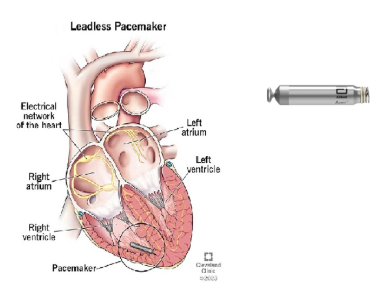Overview:
- A leadless pacemaker is a small (1 to 1.5 inches smaller than a AAA battery) one piece devices that can be implanted in the heart to treat problems due to slow heart rate.
- Implant success rate of 95% to 99%, with complication rates below 2%.
- Battery life 12 - 21 years.
Indications:
- Bradycardia with symptoms.
- Bradycardia-tachycardia syndrome (slow and fast heart rhythms).
- Atrial fibrillation or sinus rhythm with AV block.

Pros and Cons of a leadless pacemaker:
Pros:
- No chest incision or scar from pulse generator placement .
- No lump under the skin on the chest .
- Shorter procedure time than traditional pacemaker implantation.
- Shorter duration of hospital stays and can return to daily activities after 3 days.
- It’s safe to use in an MRI (magnetic resonance imaging) machine.
- Same can be explanted, when battery life each can be replaced.
Cons :
- Higher cost than traditional pacemakers.
- More serious but rare complications include the device moving out of place or internal bleeding, pericardial effusion or cardiac tamponade.